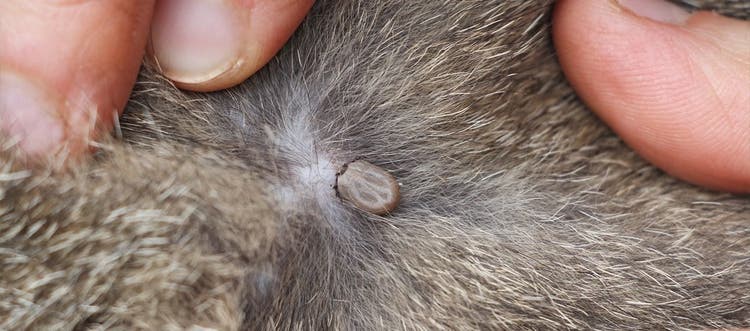Tips for removing a tick head from your pet.
Removing a tick can be tricky. If you’ve followed our step-by-step guide to twisting out a tick from your dog or cat but the mouth or entire head is still stuck in their skin, here’s what you need to know.
How to Tell If a Tick Head Is Still in Your Pet’s Skin
Not sure if you’ve removed the whole tick from your cat or dog? When removing a tick from your pet, take a look at the detached tick’s legs — if they’re moving, you’ve removed the entire tick; if they’re motionless, the head may be stuck in your pet’s skin.
Another way to tell is by looking at the area on your pet’s skin where the tick was attached. When a tick is completely removed, you should see a very small puncture wound that may be slightly bleeding. If you notice a small, dark dot resembling a splinter, the tick’s mouthparts are likely still attached.
What Happens If a Tick's Head Is Not Removed?
If a tick’s head or mouthparts are left behind after tick removal, don’t panic. You’ve killed the tick and removed its body, preventing any serious risk of disease transmission. However, leftover parts can still lead to infection at the site of attachment.
What to Do If a Tick Head Is Stuck in Your Pet’s Skin
If your cat or dog is running around with part of a tick stuck in their skin, they may not even realize it — and most of the time, it’s not cause for concern. If you removed most of the tick, the remaining parts will generally work their way out over a few days, similar to a splinter.
It’s important to disinfect and keep an eye on the area; apply antibiotic ointment or another pet-safe disinfectant and monitor your pet so you can take action if necessary. Note: Never treat the area with disinfectant if the entire tick is still attached — this can increase the risk of disease transmission.
If the affected area becomes red, swollen or painful, or has a draining sore, it’s time to book an appointment with the vet right away. Your vet will advise you on the best course of action, depending on whether the remnants of the tick are causing harm to your pet. If the affected area has already become infected, your vet may prescribe a topical antibiotic or a course of oral antibiotics to help treat it.
What Not to Do If a Tick Head Is Stuck in Your Pet
There are a few well-known home methods for removing ticks that owners may come across when researching what to do with stuck tick heads. These “hacks” are not recommended, even when parts of the tick are left in your dog or cat. Avoid the following methods:
Don’t Attempt to Extract the Tick Head Yourself
If you think you might be able to remove the tick head or mouthparts yourself with a few attempts using your tweezers, it’s better to put the tweezers down. This could make the situation worse, irritating your pet’s skin and increasing the risk of a skin infection.
Don’t Use Petroleum Jelly or Nail Polish Remover
Some believe that applying petroleum jelly or nail polish remover to a tick helps remove it, but this method is a myth. Doing this will simply irritate your pet’s skin even more.
Never Burn a Tick Off
In all situations, don’t let your pet anywhere near an open flame. Trying to remove mouthparts embedded in the skin using a flame won’t work; it may even lead to accidentally burning your poor cat or dog.
Signs a Tick Has Infected Your Pet
When removing a tick, it’s important to check that the whole tick has been detached; remember to look for the head, mouthparts and legs attached to the tick’s body to be confident you have removed the whole tick and not left anything behind.
In some cases, the stuck part of the tick may be so small that you may not realize there’s a problem until your dog or cat’s skin starts to react. Keep an eye out for swelling, redness or irritation in the attachment area for a little while after removal in case of infection. If you spot any issues, contact your vet right away.
Although uncommon, your pet may display signs of a more serious tick-borne infection, such as Lyme disease. Transmission of diseases like ehrlichiosis and anaplasmosis is another risk from ticks.
You should take your dog to the vet if they are displaying any of the following symptoms, as they may be signs of Lyme disease:
- Lost appetite
- Lethargy
- Stiff or sore joints
How to Help Avoid Tick Heads Stuck in Your Pet’s Skin
Many pet owners find tick removal difficult, and for good reason: Once ticks have started feeding, they’re locked on until they finish, which can take days. Because of this, it’s recommended owners use a tick-removal tool specifically designed to extract them whole without leaving its head or mouthparts behind. Take a look at our step-by-step guide on how to remove a tick from your dog or cat for more information on proper tick removal.
The best way to prevent tick mouthparts from getting stuck is to help prevent ticks on your pet in the first place. Protect your pet from ticks with an effective preventive product that repels and kills ticks. If your yard is prone to ticks, check out our guide to learn how to help get rid of them.

Seresto® Flea & Tick Collar for Dogs
An easy-to-use, odorless, non-greasy collar that kills and repels fleas and ticks for 8 continuous months.

Credelio® CAT (lotilaner)
Protect your feline friend with Credelio Cat, the first and only flea and tick chewable for cats.
Related Articles
Credelio® CAT (lotilaner)
Indications:
Credelio CAT kills adult fleas and is indicated for the treatment and prevention of flea infestations for one month in cats and kittens 8 weeks of age and older and weighing 2 pounds or greater.
Credelio CAT is also indicated for treatment and control of black-legged tick infestations for one month in cats and kittens 6 months of age and older and weighing 2 pounds or greater.
Important Safety Information:
Lotilaner is a member of the isoxazoline class of drugs. This class has been associated with neurologic adverse reactions including tremors, incoordination, and seizures. Neurologic adverse reactions have been reported in cats receiving isoxazoline class drugs, even in cats without a history of neurologic disorders. Use with caution in cats with a history of neurologic disorders. The safety of Credelio CAT has not been established in breeding, pregnant and lactating cats. The effectiveness of Credelio CAT against black-legged ticks in kittens less than 6 months of age has not been evaluated. The most frequently reported adverse reactions are weight loss, rapid breathing and vomiting. For complete safety information, please see Credelio CAT product label or ask your veterinarian.







